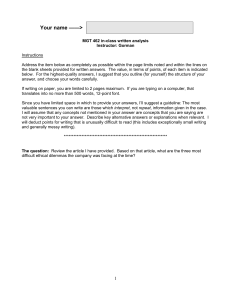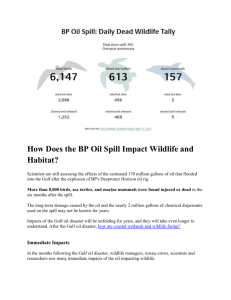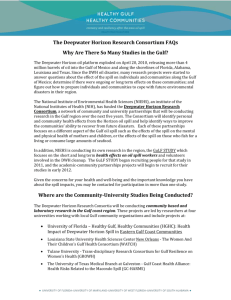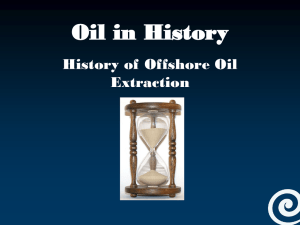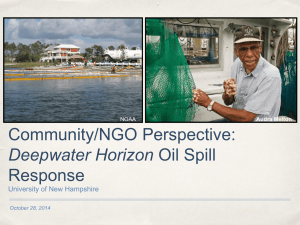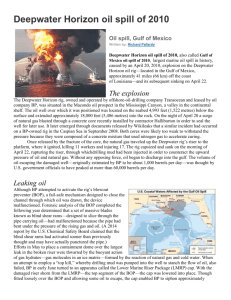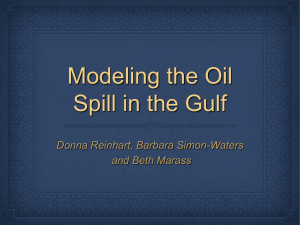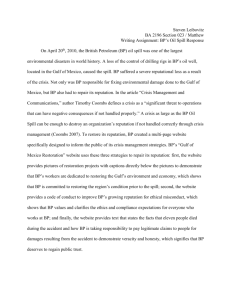Edward Emmett
advertisement
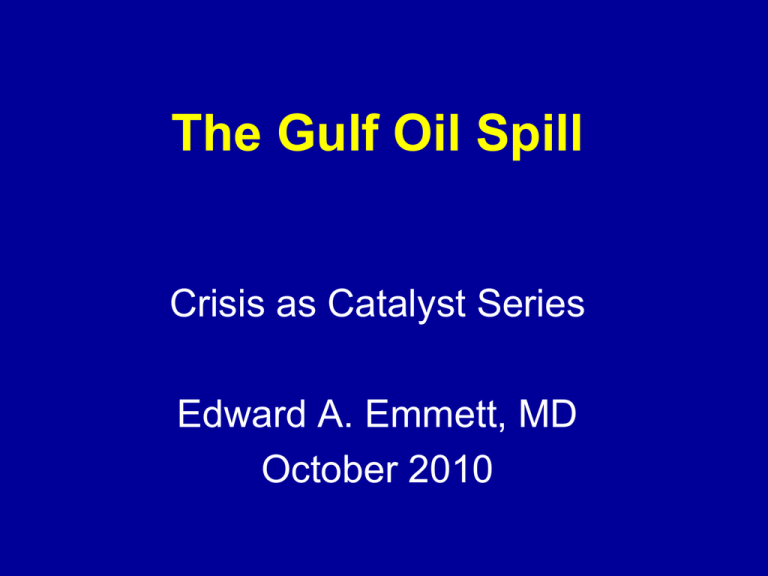
The Gulf Oil Spill Crisis as Catalyst Series Edward A. Emmett, MD October 2010 History of Offshore Oil Releases and Explosions Natural Releases Oil & Gas Exploration and Production Events Multiple with Differing Oil Types Exxon Valdez Spill (heavy thick oil) Prestige Oil Spill off Spain Explosion and Oil Release Deepwater Horizon Offshore Drilling Rig Rig Explosion In Gulf of Mexico 42 miles offshore from Venice LA, 5200 feet undersea Explosion April 10, 2010 kills 11 workers, injures 17 others, destroys rig Subsequent Oil-Leak Difficult to know exact volume of leakage, Estimated Total 4.4 + 20% Million Barrels (1bbl =42 gallons) Likely ~68,000 barrels per day Light Sweet Crude (low viscosity) Video image June 10, 2010 shows oil continuing to pour out at the site of the Deepwater Horizon oil well in the Gulf of Mexico. (AP Photo/BP PLC) Response to Spill Rescue and Recovery Cleanup Efforts > 1 M Gallons Proprietary Dispersants Used Burning Surface Oil Skimming Booms and Physical Barriers Initial Attempts at Capping Unsuccessful, Finally Capped July 15 2,500 Skimming Vessels including ~2000 “Vessels of Opportunity” (local boat operators) on Gulf by June 10 2010 A controlled oil burn is seen near the site of the Deepwater Horizon oil spill in the Gulf of Mexico, Sunday, July 11, 2010. (AP Photo/Gerald Herbert) Support vessels surrounding the Helix Q4000, the vessel being used to perform the static kill operation, Aug. 3, 2010. (AP Photo/Gerald Herbert) Oil Exposure Oil - Complex Mixture of Hydrocarbons Oils all contain similar compounds, but proportions differ (Deep Water Horizon- Light Sweet crude) Components Include Straight and branched chain hydrocarbons Aromatic Hydrocarbons (benzene, toluene, xylene etc) PAH and homologs Sulfur, some heavy metals Residues- asphaltenes (road tar) Alkyl Homologues of PAH and other aromatics – not measured by standard EPA methods Weathering of Oil in Ocean Initially the lighter components (shorter aliphatics, benzene, etc) are lost to the column of water and surface evaporation. About 50% of column has been lost when it surfaces. Emulsification results in “red mousse’ appearance Weathered oil S.G. ~similar to water -> buoyancy rising to surface, forming plumes, sinking. Dispersion enhanced by chemical dispersants (proprietary sulfonates). Biodegradation (oil-eating microbes) , photo-oxidation. Burning will form pyrolysis products (PAH, particulate matter) Tar Balls from Deepwater horizon after a few days on beach are not sticky and almost odorless. A blob of oil floats from the Gulf of Mexico into the mouth of the Mississippi River near Venice, Louisiana, on May 17. Tourists watch as Steve Gardner of Mobile scrapes oil from the sand along a 700-yard long strip of oil in Gulf Shores, Ala., Friday, June 4, 2010. (AP Photo/Dave Martin) Potential Categories of Hazards Related to Gulf Oil Spill & Response Efforts • Chemical (e.g., oil, dispersants, degreasers, soaps) • Biological (e.g., plants, animals, insects, remediation materials) • Biohazardous debris (e.g., syringes on shoreline) • Workplace injuries (e.g., slips, trips, falls, cuts) • Ergonomic stresses (e.g., repetitive stress, low back pain) • Heat stress, sunburn, and fatigue • Fires (including exposure to particulate matter) and explosions • Psychological stress • Drowning and injuries from underwater diving • Noise • Electricity Potential Toxicity of Oil 7 Studied Supertanker Oil Spills in last 50 Years • Acute eye and throat irritation, transient declines in pulmonary function, “neurologic” (nausea, vomiting, headaches), and psychological (anxiety, depression, posttraumatic stress) symptoms. • No liver, kidney, long-lasting respiratory effects • Transient DNA damage without cytotoxic changes from Prestige spill, , increased in volunteers, users of highpressure machines Physical injuries- especially associated with bird cleaning No long-term follow-up studies of Exposed Groups Specific components of concern PAH, benzene, dispersants etc Potential Routes of Chemical Exposure to Humans • Dermal • Respiratory • Ingestion – Contaminated seafood – Drinking contaminated water Schematic Exposure & Concern in Relation to Proximity to Leak (Howard NIOSH) Vulnerable Groups and Vulnerabilities Potential Vulnerable Groups Children Pregnant Diseased Mentally stressed Community Vulnerability including post Hurricanes Rita and Katrina, Environmental Justice Communities in Gulf Region Potential for Hurricanes/other weather events to disturb/disperse oil columns Sand blows across a tiger dam on beach as outer edges of Tropical Storm Alex approach the coast, Grand Isle, La., June 29, 2010. (AP Photo/Patrick Semansky) Spill: Some Important Health Effects • • • • • Deaths/Injuries in Rig Workers Acute irritation effects Heat Stress Psychological Stress Long-term exposure effects? Surveillance - Health Effects Syndromic Surveillance Data on sets of symptoms that may be exposure related. States: Hospital , ER and Urgent Care Centers (e.g. FL ESSENCE) CDC: BioSense data from DOD, VA facilities Reporting Surveillance Reports from Poison Control Centers (real-time), Physician Clinics, others Investigation of Suspected Clusters Surveillance Health Effects State Syndromic Surveillance Findings AL ERs: 29 exposure related visits in coastal Zone(18 inhalational, 8 dermal, 3 ingestion) LA : No increase in asthma or respiratory illness MS, TX No increases State Reporting Surveillance AL: 57 mild (nausea, vomiting, diarrhea, rash), 9 moderate. 50 Inhalation, 12 dermal, 4 ingestion 17 on barge ill from CO produced by malfunctioning generator LA: 108 rig or cleanup workers,35 public (headaches, nausea & throat irritation CDC Syndromic Surveillance Findings 0 to date Heat Related Problems Heat-Related Conditions Heat Stress 50-75% increase in unsafe behaviors Worse outcomes in non-acclimatized Increased associated injuries Exertional Heat Stroke Heat Fatigue Effect of cumulative exposures, impact not well understood Increased Vulnerability Gulf summer environment Exertion Personal Protective Equipment Acclimatization may be assumed Pathways for Communication and information about heat avoiding behaviors Exxon Valdez: Mental Health Consequences Several Studies somewhat hampered by protracted litigation Oiled Mayors Study • Exposure = direct contact with oil, damage or property loss, 7 disruptions to social and economic activities • Increased Odds Ratios for high v low exposure for General Anxiety Disorder (3.6), PTSD (2.6) and Depressive symptoms (2.1) Other Reports; increased use of social services, drug abuse, domestic violence, decline in traditional social relations Traditional Alaskan Natives, cleanup workers, women, families and children most vulnerable Childhood Vulnerabilty to Stress PostKatrina • Children exposed to long-term persistent stress without strong mitigating parenting (resilient, stable), likely to suffer irreversible effects with increased medical conditions in adulthood. • 2001 WTC attacks followed by increased anxiety and PTSD. • Post Katrina: – 75% of affected children demonstrated serious psychological issues – 4X rate of serious emotional disorders – 2X likelihood of too old for grade Gulf: Early Mental Health Effects • Unique Gulf Factors – Retraumatization – Hurricanes Katrina, Rita, Gustav, recent GEC – Population diversity – ethnographic/cultural – History; fishermen, tourism, Southern culture • Long-term Studies Post-Katrina Establish Baseline • Early Reports – Increased domestic violence, drug offences, focus groups reveal increased suspiciousness, arguments, depression, suicidal thoughts, alcohol consumption Crisis as Catalyst – Selected Issues Status of Surveillance Systems Research Needs Communications Leading to Preventive Actions Lessons • Agency and Federal-State coordination improved over Katrina • Some improved responses but groups such as volunteers not well dealt with. • Slow response on some items eg commencing research data gathering. • Risk communication confused “what was the health message” • Others still to be learned… Health Surveillance- Needed Improvements- State Perspectives Surveillance systems in place before Disaster were useful Issues and needs • Voluntary, unvalidated Reports • Link to exposure? Nausea, headaches from heat stress or exposure? • No monitoring for silent, unlikely to be attributed eg hypertension, cardiovascular events • Inadequate mental health monitoring • Resident/worker status undefined • Occupational groups may not be included • Workers from Interstate, where reported? • Poison Control Calls to Rocky Mountain Center • Federal funds for “episodes” not infrastructure Risk Assessment and Communication Context Many vested interests who benefit (politically, economically) from different messages or spin. Animosity towards authorities, fears of losing job if complain Lab-rat weary populations, distrust of research not leading to actionable outcomes Conflicting Foci Actionable information –provides information that guides specific actions or decisions? Communicate uncertainties -determines what new information is needed, overriding concern for scientific and agency accuracy Research - Learning from This Event and the Aftermath NIH – Long Term Epidemiologic Study • Slow response to disaster ? • Research Consortia being encouraged • $10M from NIH, Government Epidemiologists to lead Additional Research funding from BP $50M per year for 10 years ~10M /yr for Health -Mechanism of distribution yet undetermined Address Specific Important Questions Heat Stress Prevention? Answer Questions of Community Concern? Legal and Ownership Impediments to Data Acquisition

